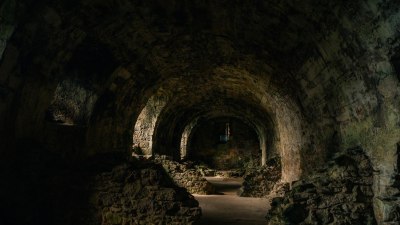Ancient Underground Temples That Will Leave You in Awe
Explore awe-inspiring ancient underground temples that showcase architectural marvels and rich histories.

Image by irabrester on Freepik
Throughout history, humanity has constructed remarkable underground temples, places of worship that mirror the grandeur and devotion of their above-ground counterparts. These hidden marvels often reflect the intricate relationship between spirituality and architecture, demonstrating the ingenuity of ancient civilizations. In this article, we will explore some of the most awe-inspiring ancient underground temples, where each structure has its own unique story and significance.
The Hypogeum of Ħal-Saflieni, Malta
The Hypogeum of Ħal-Saflieni is a UNESCO World Heritage site and one of the most remarkable archaeological treasures of Malta. Dating back to around 4000 BC, this subterranean structure was carved directly into the soft limestone and serves as a burial complex. Its intricate chambers and unique architectural features showcase the advanced engineering skills of its creators. The largest chamber, known as the Oracle Room, is renowned for its incredible acoustics, which can amplify sound dramatically, leading some historians to speculate that it might have been used for ritualistic purposes.
Rock-Hewn Churches of Lalibela, Ethiopia
The Rock-Hewn Churches of Lalibela are an extraordinary sight to behold. Carved from solid rock in the 12th century, these churches were designed to symbolize Jerusalem for Ethiopian Christians. There are eleven monolithic churches interconnected by a network of tunnels and trenches, forming a remarkable complex that attracts pilgrims and tourists alike. The most famous of these churches is Bet Giyorgis, which resembles a cross and stands as a testament to the incredible faith and skill of its builders.
Ajanta Caves, India
The Ajanta Caves, another UNESCO World Heritage site located in Maharashtra, India, are a group of rock-cut Buddhist cave monuments that date back to the 2nd century BCE to about 650 CE. The caves are adorned with stunning frescoes and carvings that provide insights into the life of the Buddha and Buddhist teachings. Their intricate details and the serene ambiance make them a mesmerizing destination for visitors. In total, there are 30 caves, each showcasing a unique aspect of Buddhist art and architecture.
Malta's Ħaġar Qim Temples
Although primarily above ground, parts of the Ħaġar Qim Temples have underground sections that complement the stunning megalithic structures. These temples, built around 3600 to 3200 BC, are some of the oldest free-standing structures in the world. The massive stone blocks used in construction weigh several tons, illustrating the impressive capabilities of Neolithic builders. Explorations of the site have also uncovered a network of underground passages and chambers used for various rituals associated with ancient cult practices.
Göreme Open-Air Museum, Turkey
In the region of Cappadocia, the Göreme Open-Air Museum features a plethora of rock-cut churches, chapels, and monastic dwellings that were carved into the soft volcanic rock. This incredible site contains frescoes dating back to the 10th century, depicting biblical scenes and figures. The underground connections between these churches reveal how early Christians used this region to practice their faith away from the prying eyes of Roman authorities. The unique volcanic formations, combined with the artistry of the frescoes, make this museum a breathtaking destination.
The Cave Temples of Dambulla, Sri Lanka
The Dambulla Cave Temples, also known as the Golden Temple of Dambulla, are a complex of caves that house impressive Buddhist rock temples. Dating back to the 1st century BCE, these caves contain more than 150 Buddha statues and numerous murals, illustrating the Jataka tales. The largest cave, known as the Mahinda Cave, is adorned with towering statues and intricate paintings, making it a significant pilgrimage site for Buddhists. The tranquil ambiance and stunning artistic expressions make the Dambulla Cave Temples an awe-inspiring destination.
Qumran Caves, Israel
The Qumran Caves, located near the Dead Sea in Israel, are historically significant as they are believed to be the home of the Essenes, a religious community that existed around the time of Jesus. These caves are where the famous Dead Sea Scrolls were discovered, containing some of the oldest known manuscripts of the Hebrew Bible. Visitors can explore the caves and understand the lifestyle of the Essenes, including their commitment to communal living and spiritual practices. The combination of history and spirituality at the Qumran Caves continues to attract scholars and tourists alike.
Underground Temples of Khajuraho, India
Known for their stunningly intricate sculptures, the temples of Khajuraho in India also have lesser-known underground components. Built between 950 and 1050 CE by the Chandela dynasty, these temples feature erotic and sensual sculptures that depict various aspects of life, love, and spirituality. While the majority of the temples are above ground, some historians suggest that there may be undiscovered subterranean aspects that may hold further secrets of ancient Indian culture and spirituality.
Batu Caves, Malaysia
The Batu Caves, located just outside Kuala Lumpur, are a series of limestone caves that house numerous Hindu shrines. The main cave, known as Temple Cave, features stunning Hindu statues and is dedicated to Lord Murugan. The colorful steps leading up to the cave shrine are adorned with vibrant statues and decorations. This site is significant for Hindu devotees, especially during the Thaipusam festival when thousands gather to pay homage. The natural beauty of the caves combined with the vibrant Hindu culture makes the Batu Caves a captivating destination.
Cappadocia Underground Cities, Turkey
Fascinating and enigmatic, the underground cities of Cappadocia reveal the ancient ingenuity of its inhabitants. Many of these cities, such as Derinkuyu and Kaymakli, were designed as sanctuaries, providing refuge for early Christians during times of persecution. These subterranean complexes include living quarters, kitchens, and even places of worship. The ventilation systems and ingenious design allow for sustaining communities underground for extended periods. Exploring these cities gives visitors a glimpse into a unique aspect of historical life in Turkey.
The Temple of Seti I, Egypt
Located in Abydos, the Temple of Seti I is one of the most important archaeological sites in Egypt. Though primarily above ground, it includes extensive subterranean corridors and chambers that add to its mystique. The temple, dedicated to Osiris, boasts some of the finest examples of ancient Egyptian wall reliefs and inscriptions. The underground sections have a reputation for mystical significance. Set against the backdrop of ancient beliefs surrounding the afterlife, the Temple of Seti I provides an extraordinary opportunity to explore Egypt's rich spiritual heritage.
From the eerily quiet corridors of the Hypogeum of Ħal-Saflieni to the intricate carvings of the Ajanta Caves, these ancient underground temples encapsulate the artistic and spiritual aspirations of their creators. Each temple represents a unique narrative that invites us to understand the cultural and historical contexts of the time. These extraordinary sites not only showcase the architectural prowess of ancient civilizations but also serve as a testament to humanity's enduring quest for meaning and connection with the divine. Whether you are drawn to the sacred atmosphere, the breathtaking artistry, or the historical significance, these underground temples offer a unique insight into the rich cultural tapestry of our shared human heritage.











